Lots of it. She found the mother lode of nesting material.
Three days ago I photographed a Lark Sparrow as she was gathering nesting material in the west desert. She was close but she was usually partially hidden by grasses in front of her so these photos are only meant to document her behavior.
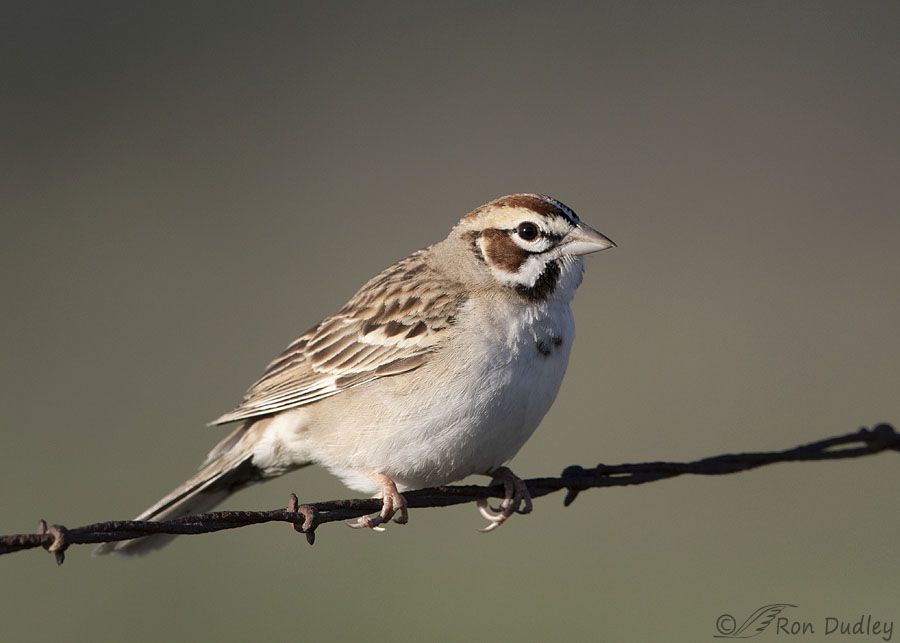
When I first saw her I had no idea she had nest-building in mind. She flew down to the scrub habitat below her and…
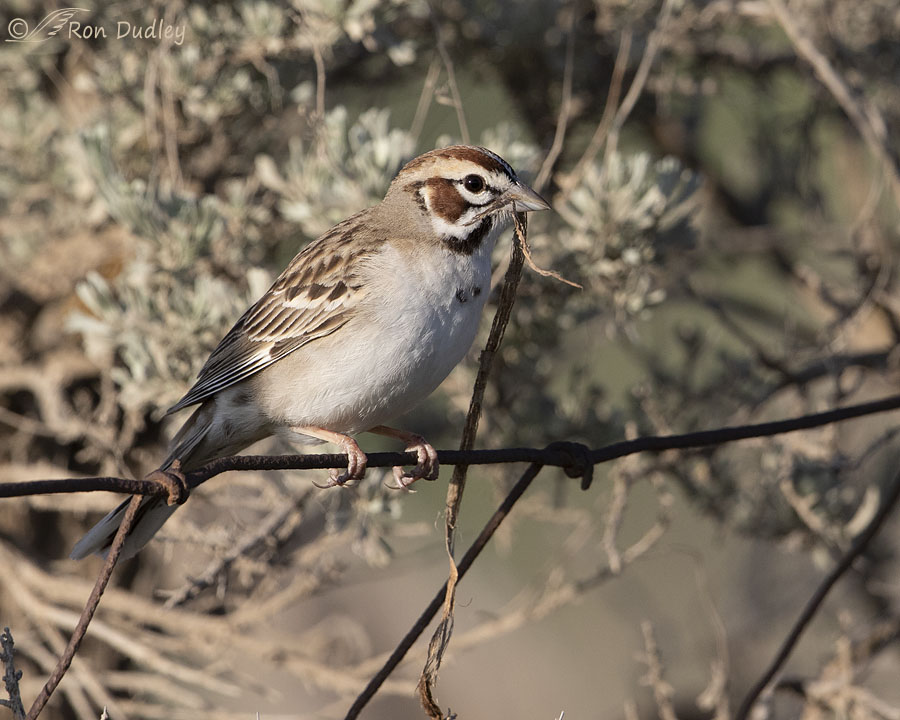 when she came back up and landed on a different portion of the fence she had nesting material in her bill. I believe the sparrow in these first two photos is the same bird but I can’t be sure. I’m referring to her as a female because in this species only the female constructs the nest.
when she came back up and landed on a different portion of the fence she had nesting material in her bill. I believe the sparrow in these first two photos is the same bird but I can’t be sure. I’m referring to her as a female because in this species only the female constructs the nest.
In this photo I’ve placed her high in the frame so we can get an indication of how long the nesting material is. Notice that it extends all the way to the bottom of the frame.
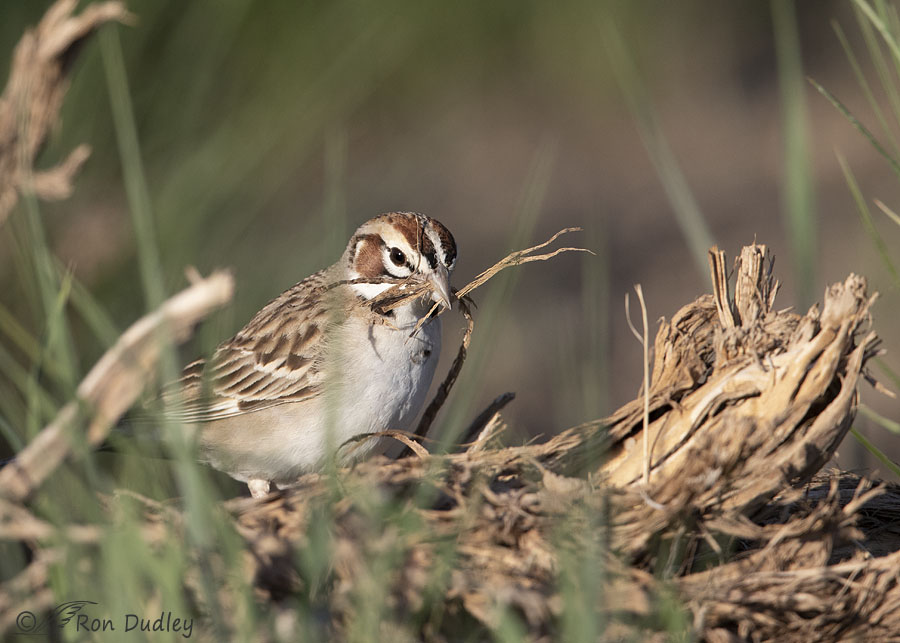
Then she found the mother lode of nesting material – an extremely weathered old juniper stump with bark and wood fibers peeling off of it. Apparently she thought that juniper wood fibers are the ideal nesting material because she went just a little bit nuts trying to get as much of it in her bill as possible.
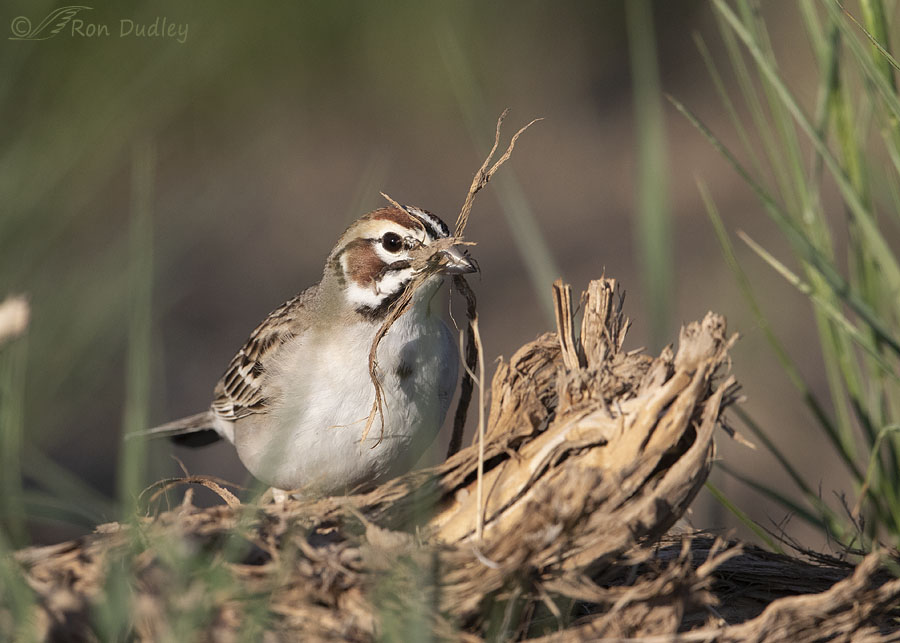
She poked around that old stump for quite a while. I had the impression that she was sometimes discarding some of the nesting material in her bill and replacing it with new pieces that she was picking up but I can’t be sure of that, even by looking carefully at my photos.
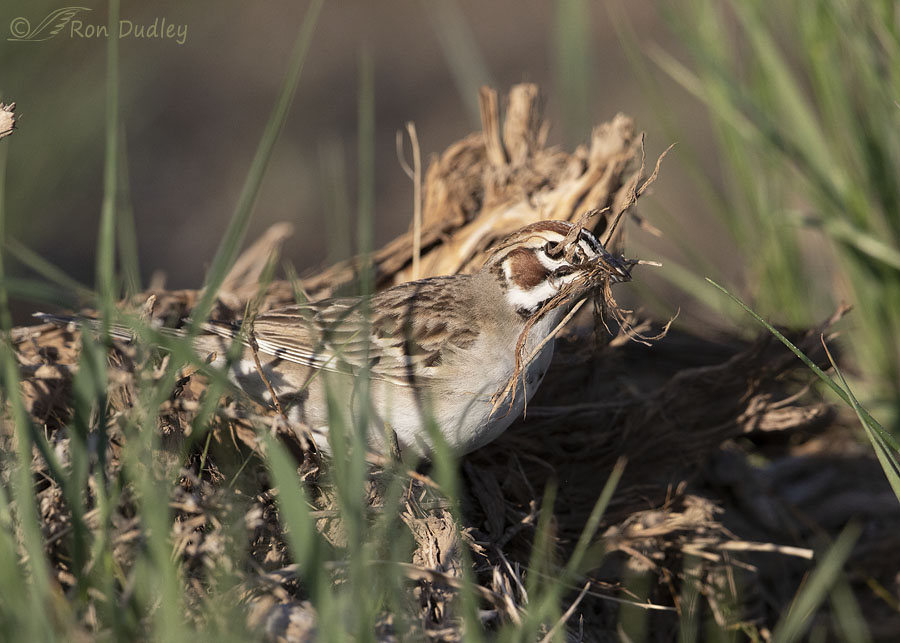
Here she’d picked up so much nesting material it obscured much of her face and blocked the catch light in her eye.
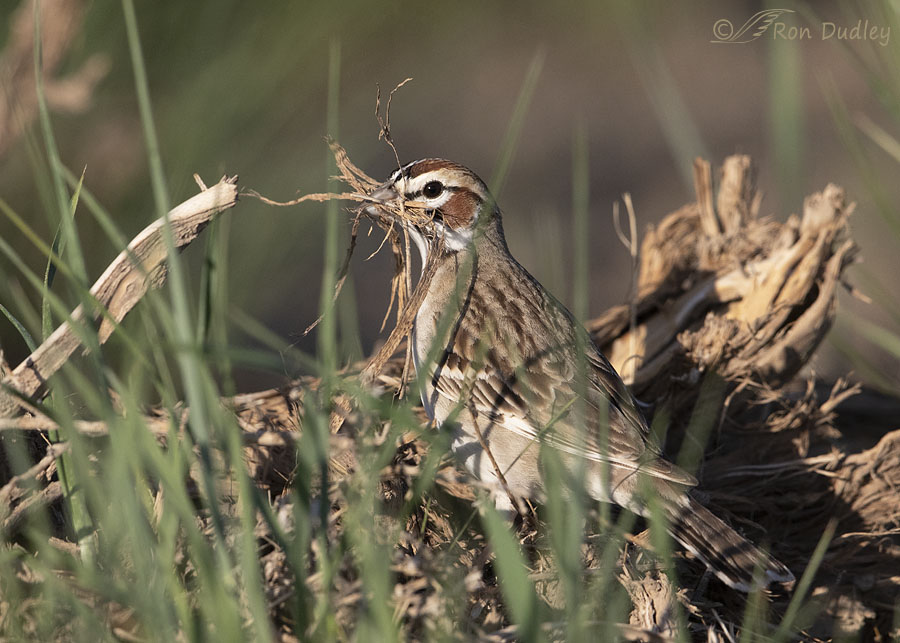
It was a challenge to focus on the bird with all the grass in front of her. Typically I use a single ‘normal’ focusing point but my camera has an option to use what I call the “micro-focusing point” with an extremely narrow sensitivity that comes in really handy in situations like this.
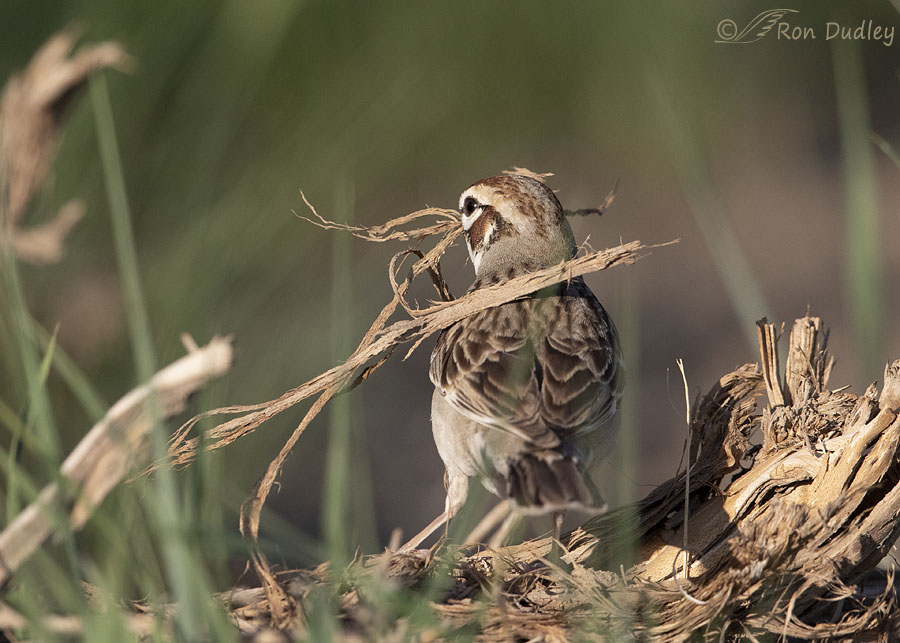
Soon after this photo was taken she flew off, presumably to her nest. I can see why, it looks like she had about all the nesting material she could handle.
I adore Lark Sparrows. I find their the unique marking on their faces, sometimes called “harlequin faces”, both interesting and appealing and some of their courtship behaviors are completely unique among songbirds. Cornell’s Birds of the World describes them this way:
- Courtship in this species differs markedly from that of other passerines. Males perform turkey-like strutting with tail upright, flashing white tail spots, and wings dropped to the ground. Unique to the Lark Sparrow is the behavior of passing a twig from male to female during copulation, which may be an alteration of courtship feeding observed in other species
Back in 2012 I photographed some of the mating behaviors of Lark Sparrows. Here’s the link if you have the interest.
Ron


Sensational series Ron!
Charlotte Norton
I love the twig-passing. 🙂
Such beautiful markings. Whomever says that LBJs are “boring” must be out of their minds! I hope that she raises lots of healthy chicks in the nest she’s building.
These are really sharp shots — whatever Canon did with your lens seems to have fixed the problem you were having. Of course, the skill of the lens operator also has much to do with the quality output! 🙂
Agreed, Marty. There’s nothing boring about Lark Sparrows, whether it’s that adorable face or their behavioral antics.
And yes, sending my rig to Canon was the cat’s meow. I just wish I hadn’t waited so long to do it. My old procrastinating tendency raising its ugly head again…
I totally understand about procrastinating. Just look at what time I finally popped over to your blog! 😂
Love all that information about the species and thanks for sharing the other link…fascinating. Awesome pics!
Much appreciated, Kellie.
She was determined not to waste the mother lode of nesting material wasn’t she?
And thank you for the link back to your earlier post.
She sure was.
Ron,
Great! Thanks for the link, too. Interesting.
Stephen
Thank you, Steven.
We also fell in love with Lark Sparrows when we lived in west Texas.
I really like this series of collecting nesting materials. And the older series of courtship images is fantastic!
Freshly stripped juniper bark smells good to me. Not sure the sparrow has the same ability to smell, but she likes it and that’s what matters!
Wally, what’s not to love with Lark Sparrows. I always look forward to their springtime behaviors.
juniper wood repels some insects
Both series are very interesting and lovely photos.
I have song sparrows in my yard and I have noticed, probably the male, has a similar strut. Song sparrows always seem to have a very erect tail but they will often sit on the neighbors fence with their tail very erect and slightly flared, wings dropped and slightly spread singing followed by an almost alarm sounding “chip, chip” in between the songs as they bounce along the top of the fence, to reposition themselves for another round of song. Is it similar to to lark sparrow?
Thanks, April. I’d have to see it to know how similar it is.
To my eyes these are amazingly sharp images. I can see why you are so enamored of this species; It’s got to be the most handsome of the “lbj’s” (I’ve not seen one in person, though). The linked post is a great education on their reproductive behavior. Intromittent: looked it up in Wikipedia. Fascinating.
Lyle, considering the grass in front of the bird I’m very happy with their sharpness. Focusing through that stuff ain’t easy.
Excellent series. She definitely believes in maximizing her pick ups to minimize her trips. That 2012 mating series is very interesting and educational – thanks for including. They are very handsome sparrows.
Referencing back to the previous naming post, if all birds were required to have a human identifier, then I would call these Dudley’s Sparrows. 🙂
“I would call these Dudley’s Sparrows”
Works for me, Everett. To hell with the proposed rule change prohibiting eponymous names… 🙂
She had a “job” at hand!. 🙂 Does look like “good” nest building material. Wonder if it has a “scent” to help repel the inevitable “bugs” in a nest? They are beautiful little birds. 🙂
“Wonder if it has a “scent” to help repel the inevitable “bugs” in a nest?”
That’s an interesting thought, Judy. It never occurred to me but I wouldn’t be surprised.
What a greaat series, Ron. Thanks for the link to the older post and congrats for capturing such a unique mating experience!
Diane, the day I took the photos in that older post was the day I became enchanted with Lark Sparrows.
Absolutely beautiful shots!
Thanks, Dick.
Yes beautiful! and a link to another great tale with beautiful photos about the courtships.
Thank you, Terri.